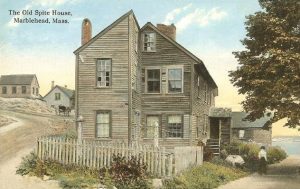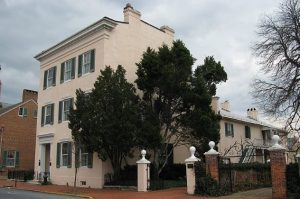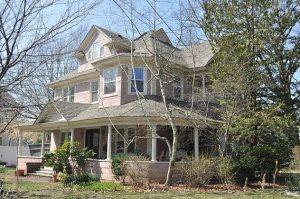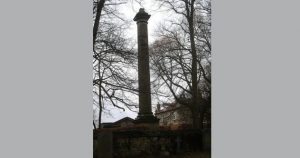A spite house is a building constructed—or sometimes substantially modified—by an aggrieved person who is ticked off at their neighbors for some reason, either real or imagined. Spite houses are pretty much exactly what they sound like in that term: buildings built out of spite! They are often not meant to be lived in or even really livable at all. But they are built in very strange ways and usually turn out to be quite impractical structures specifically for annoying a nasty neighbor or lobbing a volley in an ongoing feud over a piece of land.
Sounds pretty weird, right? But as you’ll discover while reading through this list of ten spite houses, the stories behind these buildings are both highly amusing and incredibly hard to believe. Below are ten tales of neighbors getting into vicious (and sometimes years-long) feuds and then turning around and not-so-subtly building wacky structures in a bid to win their battles. “You shall love your neighbor as yourself,” the Bible once infamously cautioned. Clearly, these people didn’t listen to that counsel!
Related: 10 Disturbing Cases Of Neighbors From Hell
10 Veh-Antiok-Xusrō
Khosrau Anushirawan – Trolling Justinian – Extra History – Part 4
Forget about a spite house for a moment; let’s start with an entire spite city! The Roman city of Antioch was completely destroyed by an earthquake in AD 526. The emperor Justin and his heir, as well as Caesar Justinian, then put up tons of money and substantial resources to rebuild it. They wanted Antioch to be strong and worthwhile again after the earthquake.
But by 541, the Iranian king Khosrow I and his men successfully carried out a siege and overtook Antioch for their own holdings. They populated it and a nearby city named Ctesiphon with Roman prisoners of war and other slaves. They then went to work building it up to their own liking.
Eventually, Khosrow emptied out Antioch and deported everybody who lived there under his forceful rule to a new city known as Veh-Antiok-Xusrō. Roman prisoners of war, slaves, unwilling subjects—everybody who lived in Antioch and other cities around the area were sent to this brand new city of Veh-Antiok-Xusrō to live and work under Iranian rule.
And here’s why it was a spite city: Veh-Antiok-Xusrō literally translates to “Better than Antioch, Khosrow built this.” Yes, that’s right—the Iranian king modeled the new town exactly after Antioch, recreated it in as much of a parallel as he could, and then bragged about how his version was better. And then he made Roman prisoners and slaves live in it! The ultimate display of power—and the ultimate show of spite.[1]
9 Old Spite House (Marblehead, MA)

Nobody is quite sure why the so-called “Old Spite House” in Marblehead, Massachusetts, looks the way it does. The house is tall, thin, and long, and two partitioned sections within it are separated and account for basically separate living quarters. It was first built in 1716 by a local sailmaker named Thomas Wood. And while the construction of the house is very unique, the stories are even crazier!
One legend has it that two brothers lived in the house together. However, they had a long-standing feud and refused to speak to each other, so one lived in one half of the long and weirdly shaped house while the other resided in the other half. A second explanation for the house’s strange long and narrow shape is that it was built at an angle and in such a way as to block the view of two other houses looking down Orne Street in Marblehead.
A third legend claims Wood built the house for its eventual owner on a tiny spit of land and in a strange construction because the resident was pissed off after receiving only a very tiny share of his father’s estate. So he wanted to block his brothers’ views from their homes with his monstrosity.
Spite or not—or whatever of those spiteful reasons is actually correct—the house is still standing today. And yes, it is still very much occupied. So, whoever lives in it now has made the weird shape and unique construction work for their family, and they would seem to be thriving in this 300-year-old house. That alone is proof that spite can last a long, long time![2]
8 The McCobb House (Rockport, ME)

In 1806, a man named Thomas McCobb returned home to Phippsburg, Maine, after years away working in business. McCobb was the rightful and main heir to his father’s land holdings and shipbuilding business there in Phippsburg. And the McCobb family had been very successful and very, very wealthy, so Thomas expected to get quite the inheritance when he showed up.
And indeed, he pocketed quite a bit of money from the value of the business. There was just one problem: his beloved childhood home, known by the family as their “Mansion in the Wilderness,” was inherited by Thomas’s stepbrother Mark. And Mark didn’t want to give it up, sell it, or move out.
Enraged that he had lost access to his childhood home and all the family memories with which he grew up, Thomas decided to build an even bigger, better, and more ornate mansion out of spite. And he built it right next door! The new McCobb mansion was much bigger than the family’s “Mansion in the Wilderness.”
The rooms were better and newer, the fixtures were modern and expensive, and the home was built in an expansive estate spread out right next to the Mansion in the Wilderness. If Thomas couldn’t live in his boyhood home, well, he wanted to elbow out his stepbrother and make his life there as unbearable as possible.
In the end, this spite house story took a bit of a turn. In 1925, the National Park Service’s Historic American Buildings Survey had the McCobb Spite House picked up and moved from Phippsburg to the Deadman’s Point area of the nearby city of Rockport. There, it was listed on the National Register of Historic Places, and it lives on today as an incredibly ornate and high-end example of early 19th century architecture in America. So the spite that motivated the house’s construction two centuries ago carries on—even if it’s in a different city about 50 miles (80 kilometers) to the north now.[3]
7 Tyler Spite House (Frederick, MD)

In 1814, a man named John Tyler (not the tenth president of the United States, but a different man) lived and worked in Frederick, Maryland. He was one of the most eminent ophthalmologists of his day. In fact, he was one of the first American-born doctors to ever perform a successful cataract operation.
So he was a big deal in Frederick and had the financial assets to be one of the town’s elites. Well, one day that year, he learned that the city government wanted to extend Record Street in downtown Frederick near the town’s Courthouse Square. That was a problem for John because he owned the land sitting along West Patrick Street in exactly the spot through which the city wanted to extend Record Street.
Tyler knew the city could come in and call out eminent domain in order to extend Record Street as they pleased. But then he found a loophole: The city was not allowed to build a road if work was already in progress on a “substantial building” in the path of the proposed street. To spite the city and prevent it from building the road right through his land, Tyler hurriedly assembled a few men and poured out a building foundation late one night.
The next morning, city workers showed up ready to carve out the extension of Record Street, and they found Tyler’s new foundation laid right in its path. The city was powerless to stop him, Record Street’s extension was scrapped, and today, Tyler’s spite house still sits at the dead end of that street’s southernmost terminus.[4]
6 Schilling Spite House (Hiawatha, KS)

In 1880, a man named Adam Schilling owned 80 acres (32 hectares) of land that directly butted up against the city limits of the small town of Hiawatha, Kansas. Feeling generous, Schilling sold three-quarters of an acre of this land to a man named James Falloon and kept the other 79-and-a-quarter acres for himself.
The city of Hiawatha was expanding then, and they wanted to buy Schilling’s acreage from him to build out the city limits and make the town bigger. Schilling was down to do that, and he wanted to see Hiawatha succeed and grow. There was just one little (really little) problem: Falloon wasn’t down to sell his tiny holding. Schilling offered Falloon a price to buy back the land, but Falloon felt the offer was beneath him and refused.
Then, somewhere along the way, the relationship between Schilling and Falloon became very contentious. Schilling built a tenement house on his property to spite his neighbor and his unwillingness to sell off his sub-one-acre land. The tenement was very low quality and had very cheap, dingy rooms. And it was only 13 feet (4 meters) away from the land marker that began Falloon’s property line!
Schilling wanted to render the neighborhood “obnoxious and unendurable” for Falloon and his family in the hopes that the man would sell back his three-quarters of an acre to Schilling, who could then turn around and sell it all to the town of Hiawatha. How spiteful![5]
5 Richardson Spite House (New York, NY)
Did a New Yorker Really Build a House Purely Out of Spite?
On the Upper East Side of New York City in the late 19th century, a man named Joseph Richardson owned a very tiny spit of land running along Lexington Avenue and 82nd Street. His land was long, running a good length down the block, but it wasn’t deep, measuring only about 5 feet (1.5 meters) in depth. The man who owned the rest of the plot on that block was Hyman Samer, and he wanted to buy out Richardson and develop a block-sized building using the entire piece of land.
So, in 1882, Samer came to Richardson with an offer: Take $1,000 for the tiny strip of land and be on your way. Samer considered the thin line of land pretty much worthless all by itself. After all, with Samer owning the rest of the block, there was little that Richardson could do with such a small line of land, right? Wrong! Richardson countered Samer’s offer with a $5,000 response. But Samer didn’t want to spend that much money on what he considered worthless land on its own, so he turned Richardson down. Then, at an impasse in the negotiations, Richardson made his move.
He constructed a long, thin apartment building running along the length of his plot. It was 104 feet (31.7 meters) in length and four stories tall. It looked like any other apartment building of the time from the outside. But the kicker was its depth: only 5 feet!
While incredibly impractical, the apartment building was actually functional, and people did live inside it. There were eight suites within the building, with each one having three rooms and a bathroom. Sadly, Richardson’s spite house eventually came down in 1915. It was replaced by an apartment building that still stands today. But what a three-decade run of spite it had![6]
4 Collinsville Spite House (Collinsville, CT)
The so-called Collinsville Spite House wasn’t actually a house at all. It was more a specifically built structure made entirely out of spite for a neighbor following a long, nasty feud that lasted through much of the 19th century. As the story goes, there was a local butcher living in the city of Collinsville, Connecticut. He didn’t care for his neighbor on the tiny town’s River Street, and his neighbor evidently responded in quite the same way.
The butcher eventually ratcheted the feud up a notch (or a dozen notches) when he built a tall, narrow structure between their two homes. The structure was more than two stories tall and only the width of a narrow staircase. It had windows all over it, and the butcher covered those windows with Venetian blinds—which were always closed.
Basically, the butcher wanted to keep the bright and warm sun away from his neighbor’s property. So he kept the blinds closed for years and years and shaded out his neighbor from the warmth of the sun. The strange and spiteful structure wasn’t livable. Still, it was apparently allowed to stand because it had a staircase and windows. And stand it did—for years and years… until the butcher died.
But there is a happy ending to this story! The butcher’s son didn’t share his father’s negative feelings toward the neighbor. So, after the butcher’s death, the son tore down the spite “house,” and order was restored to River Street. Thank goodness![7]
3 Miracle House (Freeport, NY)

In the late 19th century, in the town of Freeport, New York, a developer swooped in and had an idea to lay the town out in a grid and build a ton of homes along the new property lines. He stood to make quite a bit of money on the project, as Freeport was rapidly expanding at the time. But a competitor in the real estate development game wanted nothing to do with that. And he didn’t want to lose out on future earnings to a rival! That competitor’s name was John Randall, and at the turn of the 20th century, he wanted to stop the other developer from laying out Freeport in the way he intended.
Randall had one piece of saving grace in the competition: a triangular plot of land at the corner of Lena Avenue and Wilson Place in town. The other developer wanted to tear up the land and set out a grid of city streets running right through the plot. Randall realized his only option for stopping that developer’s claim was building a house. And so he did—practically overnight.
The so-called Freeport Spite House, which is more commonly known today as the “Miracle House,” was built on Randall’s triangular plot of land in mere hours. It went up so quickly that the grid designers had no recourse to stop it and lay out their plan.
The house itself is actually pretty normal. And it was livable then—and still is now! It’s a classic Victorian house and remains well cared-for and well-known in Freeport. And today, if you look at Freeport from above on Google Earth View, you’ll find Lena Avenue and Wilson Place are still forced to wrap awkwardly around John Randall’s house. It wasn’t what the rival developer wanted, but Randall got his way. And his impact is still being felt today with those crooked streets![8]
2 Froling Spite House (Alameda, CA)
The Alameda Spite House! The revenge house that would be impossible to build today!
At the turn of the 20th century, a man named Charles Froling owned a large plot of land in Alameda, California. He had planned to build his dream home on that land—which he had received through an inheritance. But as he was preparing to build out the home he’d always wanted to live in, suddenly an issue arose: The city of Alameda took a large portion of that land to build a street right through the middle of it.
Froling was rightfully pissed about it, but there wasn’t much that he could do. The city had their right-of-way, leaving him out in the cold. To make matters worse, though, the neighbor on the other side of the property was equally unsympathetic as the city. And that angered Froling even more.
To get back at both the city of Alameda and his uncaring neighbor, Froling built a tall and thin house that was barely deep enough to live in right on the little sliver of land he still retained. The house was 54 feet (16.5 meters) long and two stories high, but it was only 10 feet (3 meters) deep at its widest point. He even then chose to cantilever the second story out over the sidewalk of the new road to maximize his floor space and preclude any potential future zoning setbacks. That foresight proved to be wise since the Alameda spite house is still standing (and still occupied!) today.[9]
1 Edleston Spite House (Gainford, England)

In 1904, a mourning family wanted to erect a monument for their recently deceased loved one named Joseph Edleston. They owned a plot of land in Gainford, England, right next to the cemetery at St. Mary’s Church in that small village. So they asked the church if they could erect a monument for Joseph in the churchyard to remember him and his impact on their lives.
The church straight-up refused to allow Joseph’s mourning children to erect their monument, though. Then, the church made a counteroffer: instead of putting up a monument on church land, the family could donate their property to the church and then build a monument on the donated land.
That enraged Joseph’s children, so they moved to construct a revenge building out of spite. Not only did they build themselves a house on their land that overlooked the churchyard, but they took things one big and crazy step further. They also erected a massive and unsightly 40-foot (12.1-meter) tall column next to the churchyard.
It towered over the cemetery’s trees and served as a not-so-subtle reminder of both Joseph’s life and the slight they felt from the offer made by St. Mary’s Church. Today, the Edleston Spite House and the column both still stand just as they were built 120 years ago. And the house is still occupied, too—with the Roman numerals MCMIV (1904) engraved over the front door. Savage![10]
fact checked by
Darci Heikkinen
>>> Read full article>>>
Copyright for syndicated content belongs to the linked Source : Listverse – https://listverse.com/2024/06/18/the-crazy-stories-behind-10-legendary-spite-houses/










